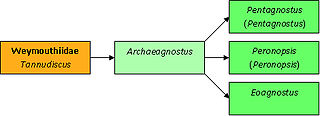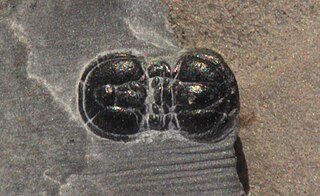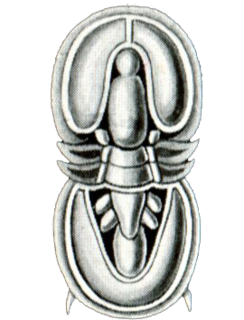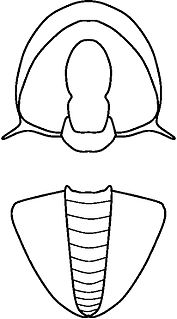
Acidiscus is an extinct genus of eodiscinid agnostid trilobites. It lived during the Botomian stage of the Cambrian period.
Acadagnostus is a genus of trilobite from the Middle Cambrian, with 7 species currently recognized. The type species A. acadicus has the widest distribution known from any peronopsid and has been found in North America, Greenland, England, Western Europe, Eastern Europe, Central Asia, the Altai Mountains, the Siberian shield, China, and Australia.

Peronopsis is a genus of trilobite restricted to the Middle Cambrian. Its remains have been found in Asia, Australia, Europe, and North America.

The Wheeler Shale is a Cambrian (c. 507 Ma) fossil locality world famous for prolific agnostid and Elrathia kingii trilobite remains and represents a Konzentrat-Lagerstätten. Varied soft bodied organisms are locally preserved, a fauna and preservation style normally associated with the more famous Burgess Shale. As such, the Wheeler Shale also represents a Konservat-Lagerstätten.

Ptychagnostus is an extinct genus of blind trilobite that lived during the Cambrian period, part of the order Agnostida. Ptychagnostidae generally do not exceed ten millimetres in length. Their remains are sometimes found in the otherwise empty tubes of the polychaete worm Selkirkia. It probably lived in the water column. Its major characteristics are lack of eyes, two lobes on the glabella, and three lobes on the pygidium.
Acmarhachis is a genus of trilobite in the order Agnostida, which lived in what are now Australia, Canada, China (Anhui), Kazakhstan, Russia (Kharaulakh), and the US. It was described by Resser in 1938, and the type species is Acmarhachis typicalis.

Glyptagnostus reticulatus is a species of agnostid trilobite belonging to the genus Glyptagnostus. It existed during the Paibian Age of the Cambrian. It has a cosmopolitan distribution and is an important index fossil in biostratigraphy. It was characterized by an unusual net-like pattern of furrows on both the cephalon and the pygidium.
Agnostotes orientalis is a species of agnostid trilobite belonging to the genus Agnostotes. It existed during the Jiangshanian Age of the Cambrian. It is an important index fossil in biostratigraphy.

Sphaeragnostus is an extinct genus from a well-known class of fossil marine arthropods, the trilobites. It can be recognized by having two thorax segments, a totally effaced headshield, while the tailshield although effaced, has a clear furrow parallel to its border, and a short, convex, subcircular axis. It lived during the Ordovician.

Itagnostus is a genus of trilobite restricted to the Middle Cambrian. Its remains have been found in Asia, Australia, Europe, and North America.
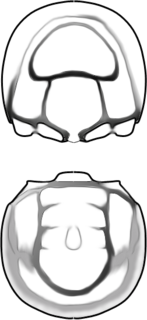
The Condylopygidae are a family of very small trilobites, that lived during the Middle Cambrian, and has been found in Canada, the Czech Republic, Germany, France, Spain, England, Wales, Sweden, and the Russian Federation (Siberia). They uniquely differ from all other Agnostina in having the frontal lobe of the central raised area of the headshield wider than the rear lobe. The Condylopygidae are the only family assigned to the Condylopygoidea superfamily.
Diplorrhina is a genus of trilobites, a well known class of extinct marine arthropods. It lived during the early Middle Cambrian in what are now the Czech Republic and the North Siberian plateau. Like all agnostina it has a headshield (or cephalon and tailshield (or pygidium of approximately the same shape and size, and two thorax segments. Like other members of the Peronopsidae family, it lacks a furrow connecting the furrow surrounding the central raise area of the cephalon and the furrow that defines the border of the cephalon. Both the cephalon and the pygidium lack spines. It is difficult to distinguish from many other peronopsids.

Toragnostus is a genus of trilobites restricted to the late Middle Cambrian. Its remains have been found in the United States, Greenland, Denmark, China, Sweden, the Russian Federation, and Kazakhstan. Its headshield and tailshield are almost completely effaced and it has two thorax segments.

Eodiscidae is a family of agnostid trilobites that lived during the final Lower Cambrian and the Middle Cambrian. They are small or very small, and have a thorax of two or three segments. Eodiscidae includes nine genera.
Schmalenseeia is genus of trilobites of uncertain affinity, that lived during the middle Middle to earliest Upper Cambrian. Species assigned to Schmalenseeia have been found in Norway, Sweden, Northern Siberia, Eastern China, Australia (Tasmania), India (Himalayas) and the United Kingdom.
Plutonides is a genus of trilobite, an extinct group of marine arthropods. Species occur in the middle Middle Cambrian of Russia (Siberia), Mongolia, England and Wales, Sweden, eastern Canada, and the Czech Republic. The frontal lobe of the central raised area of the headshield overhangs the short frontal border and it is slightly pointed, rather than rounded or truncate. This character is shared with Anabaraspis, but in Anabaraspis there is a wide area in front of the glabella without a differentiated border and preglabellar field.
![Itagnostus interstrictus - Wheeler Schale, Utah, USA - Cambrian period ([?] -507 MA) - 39.25degN 113.33degW .jpg](http://upload.wikimedia.org/wikipedia/commons/thumb/6/6b/Itagnostus_interstrictus_-_Wheeler_Shale%2C_Utah%2C_USA_-_Cambrian_period_%28%E2%89%88_-507_MA%29_-_39.25%C2%B0N_113.33%C2%B0W.jpg/220px-Itagnostus_interstrictus_-_Wheeler_Shale%2C_Utah%2C_USA_-_Cambrian_period_%28%E2%89%88_-507_MA%29_-_39.25%C2%B0N_113.33%C2%B0W.jpg)

